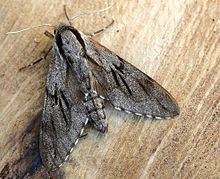Bombycoidea
| Bombycoidea | ||||||||||
|---|---|---|---|---|---|---|---|---|---|---|

Small night peacock butterfly ( Saturnia pavonia ) from the peacock moth family |
||||||||||
| Systematics | ||||||||||
|
||||||||||
| Scientific name | ||||||||||
| Bombycoidea | ||||||||||
| Latreille , 1802 |

The Bombycoidea are a superfamily of butterflies (Lepidoptera). About 3350 species are known worldwide. 79 species and subspecies have been recorded in Europe .
features
The monophyly of the superfamily is justified by the following autapomorphies : The hips ( coxes ) of the forelegs are fused at the front in the last caterpillar stage , the eighth abdominal segment of the caterpillars usually has D1 bristles that arise in the middle of the back from a hump, the wing veins Rs1 run on the forewings + Rs2 parallel near the trunk of Rs3 + Rs4 or are even grown together with this and the “4. "Muscles" in the male genitals are arranged differently than usual. The fact that the hips of the caterpillars in the Apatelodinae and some Eupterotidae are not fused and the bristles do not appear on the eighth abdominal segment in the Eupterotidae and some other subgroups is probably due to the fact that these characteristics have disappeared again with the further development of these taxa.
The Bombycoidea has in common with the two other closely related superfamilies Mimallonoidea and Lasiocampoidea that the eggs are usually of the flat type, with a rather smooth chorion , whereby in some Mimallonoidea the chorion is sculptured. However, some groups of the Bombycoidea, such as the Eupterotidae , Lemoniidae and Brahmaeidae , also have eggs of the erect type. The short to long secondary bristles of the caterpillars are usually numerous, as is the case with the Lasiocampoidea. The dolls have a stocky build and often have short antennae. The fifth and sixth abdominal segment is mobile and in some species has fine teeth on the back. Pupation takes place in many species in a spun cocoon , which is used, for example, in silk spinners for commercial silk production.
In most species, the strongly built, strongly scaled and broad-winged adults have no functional pinpoint eyes ( ocelli ). Their antennae are double, triple or quadruple pinnate in the males. This, however, with the exception of the swarmers (Sphingidae), whose antennae have lost these characteristics through further development. The veins Rs1 and Rs2 of the forewings are either stalked or completely fused. There are no tympanic organs on either the thorax or the abdomen . The mouthparts, frenulum, and retinaculum are reduced or completely absent in many species.
Systematics
The Bombycoidea are very closely related to the Mimallinidae , which are the only family of the Mimallonoidea , and the Lasiocampoidea . These three superfamilies are presumably a monophyletic group and are summarized by some authors in a common superfamily Bombycoidea. However, this is only justified by a few autapomorphies. In addition, the swarmers (Sphingidae) are also assigned to their own superfamily Sphingoidea by some authors. However, this must be regarded as wrong, since the swarmers can be placed well in the characteristics of the moths as well as the caterpillars to the group of the Bombycoidea. The Bombycoidea in this sense comprise about 3350 species. The following families are assigned to the superfamily:
- Eupterotidae
- Real spinner (Bombycidae)
- Birch moth (Endromidae)
- Mirinidae
- Peacock moth (Saturniidae)
- Carthaeidae
- Meadow moth (Lemoniidae)
- Brahmae spinner (Brahmaeidae)
- Swarmers (Sphingidae)
supporting documents
- ↑ Bombycoidea at Fauna Europaea. Retrieved February 17, 2011
- ↑ a b c d Niels P. Kristensen: Lepidoptera, moths and butterflies . In: Maximilian Fischer (Ed.): Handbook of Zoology . 1st edition. tape 4 - Arthropoda: Insecta , volume 35. de Gruyter, Berlin / New York 1998, ISBN 3-11-015704-7 (English).
- ^ A b Malcolm J. Scoble: The Lepidoptera: Form, Function and Diversity . Oxford University Press, Oxford 1995, ISBN 0-19-854952-0 (English).
literature
- Niels P. Kristensen: Lepidoptera, moths and butterflies . In: Maximilian Fischer (Ed.): Handbook of Zoology . 1st edition. tape 4 - Arthropoda: Insecta , volume 35. de Gruyter, Berlin / New York 1998, ISBN 3-11-015704-7 (English).
- Malcolm J. Scoble: The Lepidoptera: Form, Function and Diversity . Oxford University Press, Oxford 1995, ISBN 0-19-854952-0 (English).